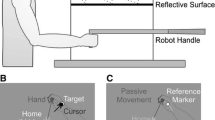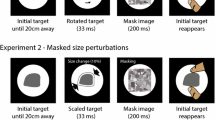Abstract
Lee et al. (Percept Psychophys 70:1032–1046, 2008a) investigated whether visual perception of metric shape could be calibrated when used to guide feedforward reaches-to-grasp. It could not. Seated participants viewed target objects (elliptical cylinders) in normal lighting using stereo vision and free head movements that allowed small (≈10°) perspective changes. The authors concluded that poor perception of metric shape was the reason reaches-to-grasp should be visually guided online. However, Bingham and Lind (Percept Psychophys 70:524–540, 2008) showed that large perspective changes (≥45°) yield good perception of metric shape. So, now we repeated the Lee et al.’s study with the addition of information from large perspective changes. The results were accurate feedforward reaches-to-grasp reflecting accurate perception of both metric shape and metric size. Large perspective changes occur when one locomotes into a workspace in which reaches-to-grasp are subsequently performed. Does the resulting perception of metric shape persist after the large perspective changes have ceased? Experiments 2 and 3 tested reaches-to-grasp with delays (Exp. 2, 5-s delay; Exp. 3, ≈16-s delay) and multiple objects to be grasped after a single viewing. Perception of metric shape and metric size persisted yielding accurate reaches-to-grasp. We advocate the study of nested actions using a dynamic approach to perception/action.






Similar content being viewed by others
Notes
In other recent work [for instance, Perotti et al. (1998) or Norman et al. (2006)], local measures of shape have been used, that is, measures of shape at a point on a curve or surface. Koenderink (1990, pp 319–324) developed both a measure of qualitative variations (cylindrical, ellipsoidal, saddle, etc.) in surface shape at a point, the “shape index”, and a measure of quantitative variations in surface curvature at a point, the “curvedness”. Such local measures are different from more global measures like the aspect ratio. A large and a small circle exhibit different 'curvedness' by definition because curvature is the inverse of the ratio of the tangent circle to a curve at a point. So, the local measure captures a different property of shape than that which corresponds to the more familiar intuition about what shape is.
We also analyzed these data by performing linear regressions separately for each participant regressing actual aspect ratios on grasp aspect ratios and recording the slope in each case. We then performed Anovas on the collected slope values. There was a single between subject factor, Experiment. In addition, there was a repeated measures factor with three levels: MGA Feedback MGA Probe and TGA Probe. The results of these analyses were the same as those in the multiple regressions reported for all experiments.
References
Anderson J, Bingham GP (2010) Proportional rate control of walking to reach. (submitted)
Bingham GP (2005) Calibration of distance and size does not calibrate shape information: comparison of dynamic monocular and static and dynamic binocular vision. Ecol Psychol 17:55–74
Bingham GP, Lind M (2008) Large continuous perspective transformations are necessary and sufficient for accurate perception of metric shape. Percept Psychophys 70:524–540
Bingham GP, Zaal FT, Robin D, Shull JA (2000) Distortions in definite distance and shape perception as measured by reaching without and with haptic feedback. J Exp Psychol Hum Percept Perform 26:1436–1460
Bingham GP, Crowell JA, Todd JT (2004) Distortions of distance and shape are not produced by a single continuous transformation of reach space. Percept Psychophys 66:152–169
Bingham GP, Coats RO, Mon-Williams M (2007) Natural prehension in the absence of haptic feedback when calibration is allowed. Neuropsychologia 45:288–294
Bingham GP, Hughes K, Mon-Williams M (2008) The coordination patterns observed when two hands reach-to-grasp separate objects. Exp Brain Res 184:283–293
Bradshaw MF, Parton AD, Glennerster A (2000) The task-dependent use of binocular disparity and motion parallex information. Vision Res 40:3725–3734
Brenner E, van Damme WJM (1999) Perceived distance, shape and size. Vision Res 39:975–986
Churchill A, Hopkins B, Rönnqvist L (2000) Vision of the hand and environmental context in human prehension. Exp Brain Res 134:81–89
Coats R, Bingham GP, Mon-Williams M (2008) Calibrating grasp size and reach distance: interactions reveal integral organization of reaching-to-grasp movements. Exp Brain Res 189:211–220
Cuijpers RH, Smeets JB, Brenner E (2004) On the relation between object shape and grasping kinematics. J Neurophysiol 91:2598–2606
Cutting JE, Vishton PM (1995) Perceiving layout and knowing distances: the integration, relative potency, and contextual use of different information about depth. In: Epstein W, Rogers S (eds) Perception of space and motion. Academic Press, San Diego
Gillam B (1995) The perception of spatial layout from static optical information. In: Epstein W, Rogers S (eds) Perception of space and motion. Academic Press, San Diego
Hibbard PB, Bradshaw MF (2003) Reaching for virtual objects: binocular disparity and the control of prehension. Exp Brain Res 148:196–201
Hu Y, Eagleson R, Goodale MA (1999) The effects of delay on the kinematics of grasping. Exp Brain Res 126:109–116
Iberall T, Bingham GP, Arbib MA (1986) Opposition space as a structuring concept for the analysis of skilled hand movements. Experimental brain research series 15. Springer, Heidelberg
Indow T, Inoue E, Matsushima K (1962a) An experimental study of the Luneburg theory of binocular space perception: 1. The 3- and 4-point experiments. Jpn Psychol Res 4:6–16
Indow T, Inoue E, Matsushima K (1962b) An experimental study of the Luneburg theory of binocular space perception: 2. The alley experiments. Jpn Psychol Res 4:17–24
Johnston EB (1991) Systematic distortions of shape from stereopsis. Vis Res 31:1351–1360
Koenderink JJ (1990) Solid shape. MIT, Cambrige
Lee Y, Lind M, Bingham GP (2007) Shape perception is merely ambiguous, not systematically distorted. J Vis 7(9):842a
Lee Y, Crabtree CE, Norman JF, Bingham GP (2008a) Poor shape perception is the reason reaches-to-grasp are visually guided online. Percept Psychophys 70:1032–1046
Lee Y, Lind M, Bingham GP (2008b) Metric shape perception requires a 45° continuous perspective change. J Vis 8(6):759a
Lind M, Bingham GP, Forsell C (2003) Metric 3D structure in visualizations. Inf Vis 2:51–57
Luneburg RK (1950) The metric of binocular visual space. J Opt Soc Am 40:627–642
Melmoth DR, Grant S (2006) Advantages of binocular vision for the control of reaching and grasping. Exp Brain Res 171:371–388
Milner AD, Goodale MA (1996) The visual brain in action. Oxford University Press, Oxford
Mon-Williams M, Bingham GP (2005) Task constraints alter prehension movements qualitatively and quantitatively. J Vis 5(8):124a
Mon-Williams M, Bingham GP (2007) Calibrating reach distance to visual targets. J Exp Psychol Hum Percept Perform 33:645–656
Mon-Williams M, Bingham GP (2010) Stop, fly-through and slam: affordances and the spatial structure of reaches-to-grasp. (submitted)
Mon-Williams M, Coats R, Bingham GP (2004) Reaching with feeling. J Vis 4(8):411a
Norman JF, Lappin JS (1992) The detection of surface curvatures defined by optical motion. Percept Psychophys 51:386–396
Norman JF, Todd JT (1993) The perceptual analysis of structure from motion for rotating objects undergoing affine stretching transformations. Percept Psychophys 53:279–291
Norman JF, Todd JT (1996) The discriminability of local surface structure. Perception 25:381–398
Norman JF, Todd JT, Phillips F (1995) The visual perception of surface orientation from multiple sources of optical information. Percept Psychophys 57:629–636
Norman JF, Todd JT, Norman HF, Clayton AM, McBride TR (2006) Visual discrimination of local surface structure: slant, tilt, and curvedness. Vis Res 46:1057–1069
Pedhazur EJ (1982) Multiple regression in behavioral research: explanation and prediction, 2nd edn. Holt, Rinehart & Winston, New York
Perotti VJ, Todd JT, Lappin JS, Phillips F (1998) The perception of surface curvature from optical motion. Percept Psychophys 60:377–388
Peterson MA (2003) On figures, grounds, and varieties of surface completion. Perceptual organization in vision: Behavioral and neural perspectives. In: Kimchi R, Behrmann M, Olson CR (eds) Perceptual organization in vision: behavioral and neural perspectives. Lawrence Erlbaum Associates, Mahwah, pp 87–116
Tittle JS, Braunstein ML (1993) Recovery of 3-D shape from binocular disparity and structure from motion. Percept Psychophys 54:157–169
Tittle JS, Todd JT, Perotti VJ, Norman JF (1995) Systematic distortion of perceived three-dimensional structure from motion and binocular stereopsis. J Exp Psychol Hum Percept Perform 21:663–678
Todd JT, Bressan P (1990) The perception of 3-dimensional affine structure from minimal apparent motion sequences. Percept Psychophys 48:419–430
Todd JT, Norman JF (1991) The visual perception of smoothly curved surfaces from minimal apparent motion sequences. Percept Psychophys 50:509–523
Todd JT, Norman JF (2003) The visual perception of 3-D shape from multiple cues: are observers capable of perceiving metric structure? Percept Psychophys 65:31–47
Todd JT, Tittle JS, Norman JF (1995) Distortions of three-dimensional space in the perceptual analysis of motion and stereo. Perception 24:75–86
Wann JP, Edgar P, Blair D (1993) Time-to-contact judgment in the locomotion of adults and preschool children. J Exp Psychol Hum Percept Perform 19:1053–1065
Watt SJ, Bradshaw MF (2000) Binocular cues are important in controlling the grasp but not the reach in natural prehension movements. Neuropsychologia 38:1473–1481
Watt SJ, Bradshaw MF (2003) The visual control of reaching and grasping: binocular disparity and motion parallex. J Exp Psychol Hum Percept Perform 29:404–415
Author information
Authors and Affiliations
Corresponding author
Rights and permissions
About this article
Cite this article
Lee, YL., Bingham, G.P. Large perspective changes yield perception of metric shape that allows accurate feedforward reaches-to-grasp and it persists after the optic flow has stopped!. Exp Brain Res 204, 559–573 (2010). https://doi.org/10.1007/s00221-010-2323-2
Received:
Accepted:
Published:
Issue Date:
DOI: https://doi.org/10.1007/s00221-010-2323-2




